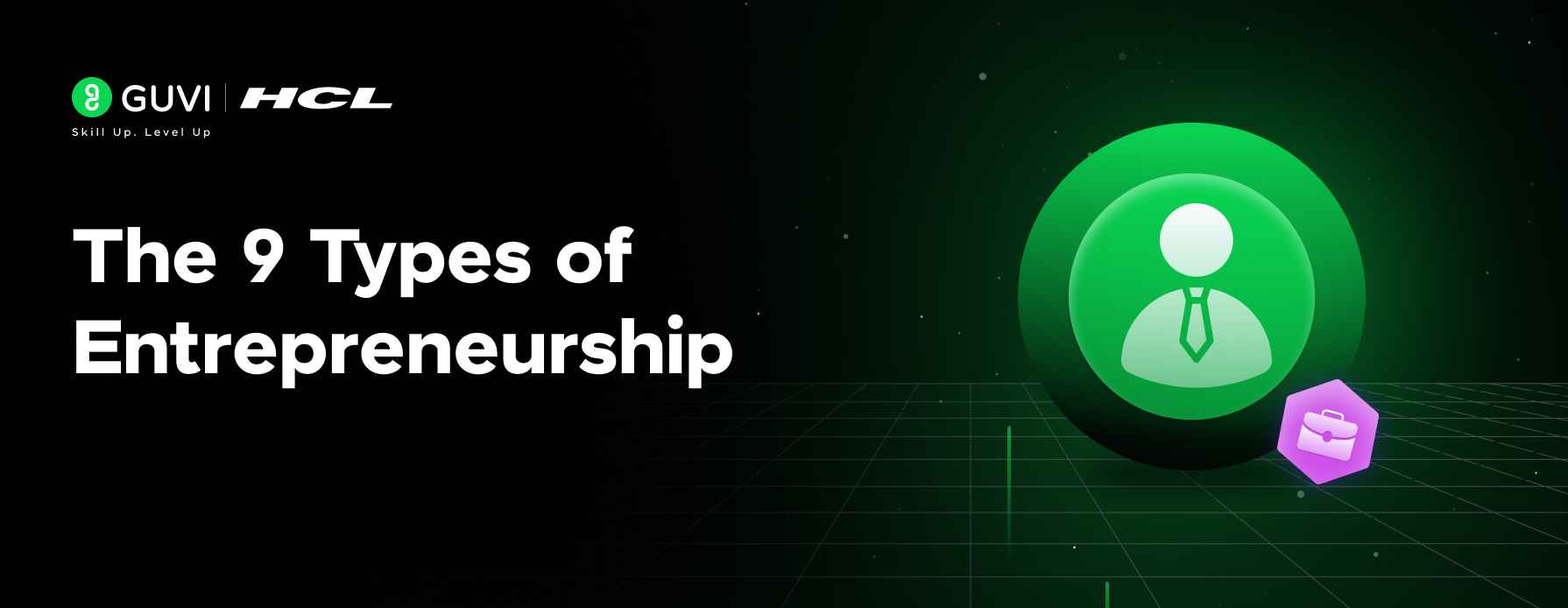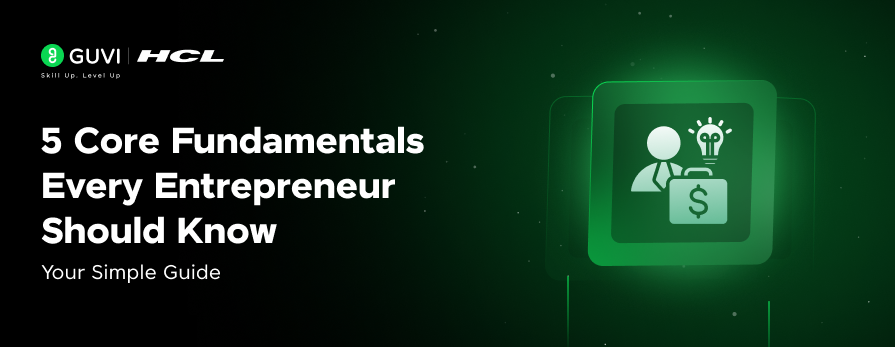
Are you curious to start your own business? But you don’t have the basic knowledge of entrepreneurship and the types of entrepreneurship to get started? You’ve reached the right place!
In this blog, we will cover the basics of entrepreneurship, types of entrepreneurship, entrepreneurs’ roles and responsibilities, and how you can get started with your own business. Get ready with your notebook and let’s get started!
Table of contents
- What is Entrepreneurship?
- Who is an entrepreneur? - Responsibilities
- Types of Entrepreneurship
- Small Business Entrepreneurship
- Scalable Startup Entrepreneurship
- Intrapreneurship
- Social Entrepreneurship
- Innovative Entrepreneurship
- Hustler Entrepreneurship
- Imitator Entrepreneurship
- Research Entrepreneurship
- Buyer Entrepreneurship
- Getting Started with HCL Guvi
- Conclusion
- FAQs
- Q1. Who can become an entrepreneur?
- Q2. What are the key qualities of a successful entrepreneur?
- Q3. How do entrepreneurs make money?
- Q4. What is the biggest challenge in entrepreneurship?
What is Entrepreneurship?
Entrepreneurship is the process of creating and running a new business to make a profit. It involves the entire process of identifying a business opportunity, taking financial risks, organizing resources, and building it together to create and grow the business. It includes innovation, risk-taking, resource management, leadership, and value creation.
Who is an entrepreneur? – Responsibilities
An entrepreneur is a person who identifies a business opportunity, creates and grows the business by taking a huge financial risk in the hope of making a profit. They are the problem solvers, risk takers, innovators and leaders who create value in the marketplace. The responsibilities of an entrepreneur include:

- They are responsible for creating a business plan that outlines the vision, goals, and financial strategy.
- They raise capital funding from investors, banks, or from personal savings.
- They design and refine the product based on the market needs.
- They recruit the right people and create a productive work environment.
- They promote the business and drive revenue through different marketing tactics.
- In the early-stage startup, they manage the budgets, accounting to ensure profitability.
- They build strong relationships with customers, partners, and stakeholders.
Types of Entrepreneurship
Based on the business size and its service, entrepreneurship is divided into nine types. In this section, we will look into the 9 types of entrepreneurship.

Small Business Entrepreneurship
- Small business entrepreneurship involves starting and running a small-scale business that only covers the local area and its operations.
- It is often established to sustain the livelihood of the local community rather than grow into a large company.
- The funding for this type of business is usually from the founder’s personal savings and small business loans.
- Examples of small businesses include local area shops, restaurants, and hair salons.
Scalable Startup Entrepreneurship
- These businesses are designed to grow rapidly and serve large markets using technology to promote and advertise.
- It usually starts small and focuses on high growth and aims for a large market impact.
- The funding for this type of entrepreneurship comes from venture capitalists and angel investors.
- Examples for scalable startup entrepreneurship include Google, Facebook, and User in their startup stages.
Intrapreneurship
- Intrapreneurship is also known as large company entrepreneurship. It is innovation existing within a large company to develop new products or services.
- The main goal of this intrapreneurship is to stay competitive and relevant in this changing market.
- The large company provides the internal corporate funding to develop new services for them.
- Examples include Google creating Gemini AI.
Social Entrepreneurship
- Social entrepreneurship involves creating businesses aimed at solving social, cultural, and environmental problems.
- This aims towards social impact and sustainability over profit.
- This type of entrepreneurship gets funding from donations, grants, and social impact investors.
- Examples include non-profit organizations.
Innovative Entrepreneurship
- Innovative entrepreneurship focuses on inventing new markets, products, methods, and technologies.
- The innovative product changes how people live or work through innovation.
- This type of entrepreneurship gets funding from angel investors, research grants, and venture capital.
- Examples of innovative entrepreneurship include Tesla and SpaceX.
Hustler Entrepreneurship
- In hustler entrepreneurship, entrepreneurs rely on their hard work, persistence, and determination to start the business with little capital.
- It grows slowly through personal effort and low-risk investment.
- This type of entrepreneurship purely depends on self-funding and reinvested profits.
- Examples include door-to-door salespeople.
Imitator Entrepreneurship
- In this type of entrepreneurship, entrepreneurs copy or improve existing business ideas or models to create their own version.
- It leverages proven models for lower risk and is based on loans and personal funding.
- Examples include opening a franchise or starting a local version of a successful product.
Research Entrepreneurship
- This type of entrepreneurship is also known as academic entrepreneurship.
- It commercializes research and academic findings from data into a marketable product or service.
- It focuses on turning knowledge into innovation and business.
- It gets funding from research grants, government programs, and partnerships.
Buyer Entrepreneurship
- In this type of entrepreneurship, entrepreneurs use their wealth to buy businesses that will be successful.
- It involves identifying promising businesses and acquiring them.
- This type of entrepreneurship involves less risk and is established from personal funding.
- Examples include trading.
Getting Started with HCL Guvi
If you are interested in starting your journey as an entrepreneur, consider enrolling in HCL Guvi’s Entrepreneurship Course. It provides a detailed roadmap towards your entrepreneurship journey under 7 hours. By taking this course, you can launch your own business within a few months.
Conclusion
In conclusion, the types of entrepreneurship will expand further according to the changes in the market. To establish a successful business and become an entrepreneur, choose the type of entrepreneurship your businesses belong to. Choosing an entrepreneurship is crucial because it helps in crafting sales and marketing strategies accordingly. Happy Building!
FAQs
Q1. Who can become an entrepreneur?
Anyone with a business idea, passion, and willingness to take risks and learn can become an entrepreneur regardless of age, background, or education.
Q2. What are the key qualities of a successful entrepreneur?
Key qualities include creativity, resilience, leadership, risk tolerance, adaptability, and strong problem-solving skills.
Q3. How do entrepreneurs make money?
Entrepreneurs earn money by selling products or services that solve problems or meet needs in the market, generating revenue and profit over time.
Q4. What is the biggest challenge in entrepreneurship?
The biggest challenge is managing risk and uncertainty, especially in funding, competition, and building a customer base.




































Did you enjoy this article?